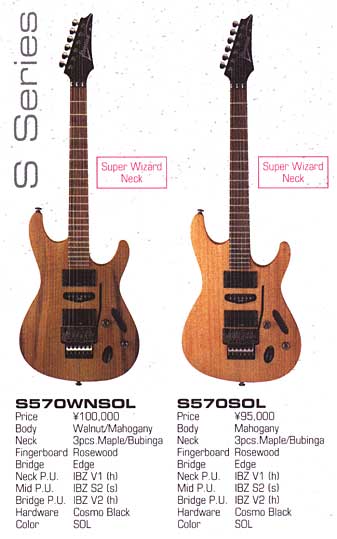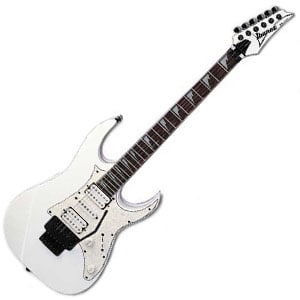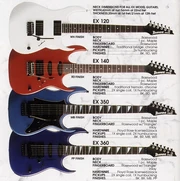The modern era of Ibanez guitars began in 1957 and the late 1950s and 1960s Ibanez catalogues show guitars with some wild looking designs. Japanese guitar makers in the 1960s were mostly copying European guitar designs and some of the late 1960s Ibanez designs were similar to and guitar designs. Hoshino Gakki used the and Gakki guitar factories to manufacture Ibanez guitars after they stopped manufacturing their own guitars in 1966 and after the Teisco guitar factory closed down in 1969/1970 Hoshino Gakki used the FujiGen Gakki guitar factory to make most Ibanez guitars. In the 1960s Japanese guitar makers started to mainly copy American guitar designs and Ibanez branded copies of, and models started to appear.
This resulted in the so called Ibanez period. After the lawsuit period Hoshino Gakki introduced Ibanez models that were not copies of the Gibson or Fender designs such as the and Ibanez Roadstar. The company has produced its own guitar designs ever since.
The late 1980s and early 1990s were an important period for the Ibanez brand. Hoshino Gakki's relationship with 's former guitarist resulted in the introduction of the and the models and after the earlier successes of the Roadstar and Iceman models in the late 1970s/early 1980s, Hoshino Gakki entered the market with the which were a lower priced version of the Ibanez JEM model. Hoshino Gakki also had semi acoustic, nylon and steel stringed acoustic guitars manufactured under the Ibanez name. Most Ibanez guitars were made for Hoshino Gakki by the FujiGen guitar factory in Japan up until the mid to late 1980s and from then on Ibanez guitars have also been made in other Asian countries such as Korea, China and Indonesia. During the early 1980s the FujiGen guitar factory also produced most of the, including the -style Roland G-505, the twin-humbucker Roland G-202 (endorsed by, and ) and the Ibanez X-ING IMG-2010. Guitar brands such as shared some Ibanez guitar designs.
The Antoria guitar brand was managed by JT Coppock Leeds Ltd England. CSL was a brand name managed by Charles Summerfield Ltd England.
Maurice Summerfield of the Charles Summerfield Ltd company contributed some design ideas to Hoshino Gakki and also imported Ibanez and CSL guitars into the with Hoshino Gakki cooperation from 1964-1987. The Maxxas brand name came about because Hoshino Gakki thought that the guitar did not fit in with the Ibanez model range and was therefore named Maxxas by Rich Lasner from Hoshino USA. Harry Rosenbloom, founder of the (now-bankrupt) Medley Music of Bryn Mawr, Pennsylvania, was manufacturing handmade guitars under the name 'Elger.' By 1965 Rosenbloom had decided to stop manufacturing guitars and chose to become the exclusive North American distributor for Ibanez guitars. In September 1972 Hoshino began a partnership with Elger Guitars to import guitars from Japan. In September 1981, Elger was renamed 'Hoshino U.S.A.'


, retaining the company headquarters in as a distribution and quality-control center. Custom modified 05 S470. series, also known as the Saber series, are famous for having ergonomic, super thin, and lightweight bodies. RT series - Superstrat design with 24 frets. Discontinued in 1994. RX series - Superstrat design but with 22 frets instead.
Discontinued in 1998, and currently only exists as GRX (budget model of RX series). AX series - Extreme version of the artist model, aimed towards metal players - currently only exist as GAX model and Guitar Center exclusive model.
Axstar (aka Axstar by Ibanez) - discontinued. EDR/EXR - Ergodyne series - discontinued.
Ibanez Artist AS200 semi hollowbody from the1980s. Artist Series - In the mid-70's Ibanez started producing a line of double cutaway solid body guitars.
Ibanez Ex Series Korea Serial Number List
Some of these featured tri-sound switches which enabled the player to alter the humbucking pickups to single coil or out of phase modes. There were various models, the best known of which, produced in the 1980s, are the AR100, AR105, AR150 (all without the tri-sound) and AR300, AR305, AR350 (all featuring the tri-sound). The artist series established the company as manufacturers of high quality original instruments.
Early endorsers included Bob Weir and Steve Miller.
IBANEZ RULES!! - IBANEZ FAKES FAKES The proliferation of fake guitars being sold today has promptedme to give them their own page.
These largely Chinese made fake Ibanez are whatprompted Ibanez to release substandard guitars like the JEM333 and PGM3 at pricepoints to compete with these fakes.Many of these auction are valid auctions and you may ask how canthey afford to sell a guitar for 10 cents and I've seen a few close that low. Checkthe shipping rates. Largely targeted to the UK market, 288 pounds for EMS or188 pounds for 'surface' is actually 2-3 times the actual cost of shippingand include the built in profit margin for the fake guitar. After you take intoconsideration how cheap it is to have a guitar built in China it will all makesense.In addition to these purely dishonest sellers that claim to beselling real Ibanez but deliver fakes, are the massive amounts of con auctionsbased around these guitars. Quite simply if you're bidding on any auction fromChina you're just begging to get screwed in one way or another.
I have seen somereal Ibanez Artcore Chinese auctions because those guitars are cheap and areChinese made, and again, the shipping is where you are paying for the guitar.You're MUCH better off buying from your local dealer where you have warrantycoverage to protect you from the inherent problems found in the grade of guitars these are.Complicating the whole mess is many of these fakes have beenimported by honest and dishonest sellers, and some who are honest but as dumb asrocks and think they're actually selling something real. Many to most of thesehave fake 'Made In Korea' markings and serial numbers starting with C so youmight actually think it's really made by Cort, but there is no mistake they arebeing made in China. Hopefully I can getenough examples shown to cover everything that's made.The guitars themselves are clearly bogus to all but the inept asthey're more a caricature of a real Ibanez than anything, but some of theintentional poor quality pictures can blur the reality. If in doubt all you needto do is study the details and the facts will reveal themselves.
Here are some examples of thesefakes.Ibanez Japan has made a public service announcement whichamounts to little more than notice that fakes exist and that there are a lot ofthem on 'auction sites'. JEM7VWH - Authentic, Team J Craft version which have the EdgePro trem, the most commonly faked VWH's today. You will see a pregression ofstickers added to the back of the headstock since the first TJC branding in2005, adding complience stickers for Euro distribution.
The proof is not in thestickers, but in all the details of the guitar, the hardware, screw locations,everything! The fakes are getting much closer, especially when trying to judgeby bad pictures, but there is always something out of place.

Ibanez Ex Series Korea Serial Number Lookup
Don't stop untilyou find it.JEM7VWH JEM77FP JEM555WH also called the JEM JR JEM555WH JEM555WH - Black hardware JEM555WH - Chrome hardware JEM555 with chrome JEM555 - Terrible JEM Hardtail JEM777VBK JEM?BK JEM Blue JEM Red JEM Wine JEM ish Blue with Sharkfins RG1550 / JEM JS2000 JS2000 JS2000 Blue PGM30 with JEM555 markings LOL PGM30 PGM30JB K7 RG - Blue RG Gray RGish - Black S / JEM Blue S - Blue SZ520 Red Disclaimer - Ibanez Rules is not affiliated with Ibanez or Hoshino USA.Copyright August 2000 by Ibanez Rules!!